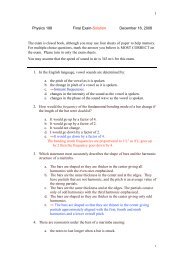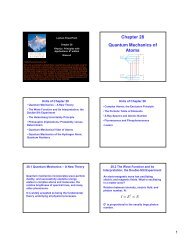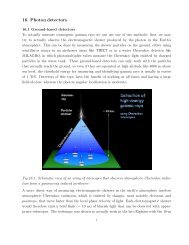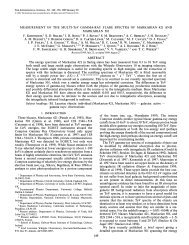Gamma-Rays Produced in Cosmic-Ray Interactions and TeV-band ...
Gamma-Rays Produced in Cosmic-Ray Interactions and TeV-band ...
Gamma-Rays Produced in Cosmic-Ray Interactions and TeV-band ...
You also want an ePaper? Increase the reach of your titles
YUMPU automatically turns print PDFs into web optimized ePapers that Google loves.
the nuclear cascades <strong>in</strong> the nuclear <strong>in</strong>teractions. The contribution from the baryon resonances,<br />
either ∆(1232) or ∆(1600), has a very narrow spike-like characteristic at energies<br />
close to pion production threshold, <strong>and</strong> is sometimes added by h<strong>and</strong> to parametrizations of<br />
the differential cross section [24].<br />
We therefore use the parametrizations [21, 24] <strong>in</strong>clud<strong>in</strong>g pion production <strong>and</strong> resonance<br />
production below a total energy E p < 20 GeV. For E p > 20 GeV, the production is given<br />
by the DPMJET-III simulation; for E p < 2.5 GeV, it is purely parametric with resonance<br />
production <strong>in</strong>cluded; for 2.5 GeV ≤ E p ≤ 20 GeV, a l<strong>in</strong>ear comb<strong>in</strong>ation <strong>in</strong> energy is used<br />
to transition from the parametrization to the DPMJET-III results. The f<strong>in</strong>al production<br />
spectra of secondary particles are smooth <strong>and</strong> still reta<strong>in</strong> agreement with experimental data.<br />
We use DPMJET to calculate energy-dependent weight factors, that allow us to parametrically<br />
account for p + ISM <strong>and</strong> He + ISM collisions <strong>in</strong> the parametrization approach, that<br />
has been trictly derived for p + p collisions only. The weights show no strong dependence<br />
on energy of the projectile particle.<br />
A remark is <strong>in</strong> order drawn on the parametrization of pion production, that we use at low<br />
cosmic-ray energies. The functional form of the pion multiplicity spectra violates k<strong>in</strong>ematic<br />
limits, so typically a few percent of pions appear to have energies higher than possible. A<br />
truncation of the multiplicity spectra at the k<strong>in</strong>ematic limit would modify the mean energy<br />
of pions, thus chang<strong>in</strong>g the γ-ray spectra. As the parametrization is a best fit to data, any<br />
modifiction would <strong>in</strong> pr<strong>in</strong>ciple deteriorate the fit. We therefore decided not to correct for<br />
the violation of k<strong>in</strong>ematic limits.<br />
C. Decay channels of secondary particles to γ-rays<br />
The isobar model is based on the theory that π production <strong>in</strong> p + p collisions near the<br />
threshold is mediated by the excitation of the ∆ 3/2 isobar, which subsequently decays <strong>in</strong>to<br />
a nucleon <strong>and</strong> pions [42]. In this work, the produced isobar is assumed to carry momentum<br />
directly forward <strong>and</strong> backward <strong>in</strong> the center-of-mass system of the collisions with an equal<br />
probability, <strong>and</strong> then decays isotropically <strong>in</strong>to a nucleon <strong>and</strong> π 0 ’s.<br />
The decay modes <strong>and</strong> decay fractions for resonances are considered as follows based on<br />
the Particle Data Group [43].<br />
∆(1232) → p + π 0 ;<br />
7







